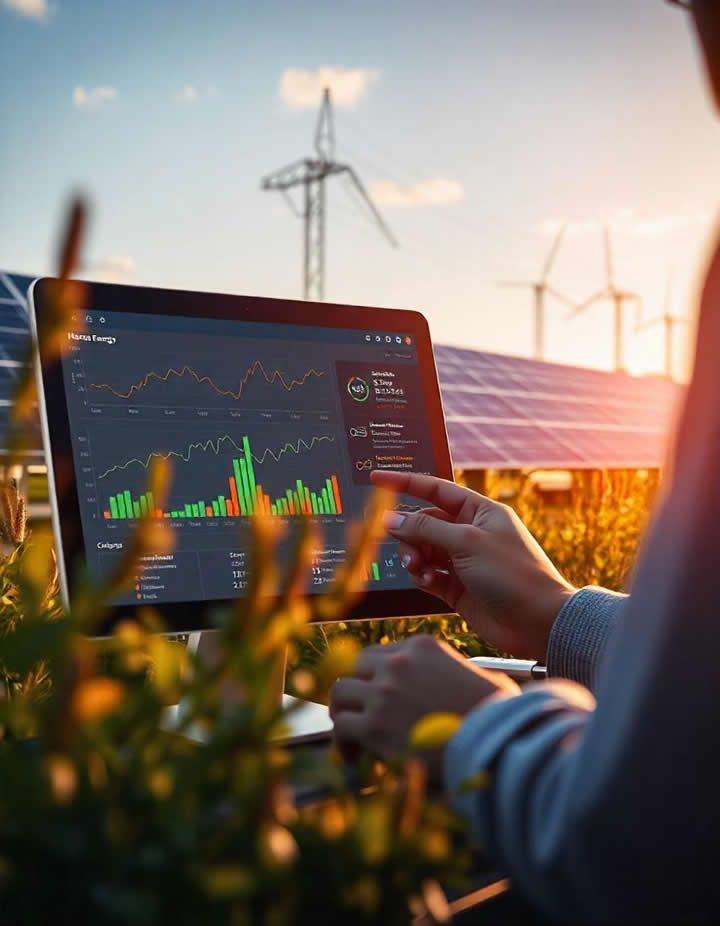Solar and storage plants aren’t one machine; they’re actually decentralized, interconnected ecosystems. Rows of solar panels capture sunlight and generate electricity, while BESS systems store that energy in rows of batteries packed together.
 Insights from Data
Insights from Data

Kitty Chachra, Co-Founder & Chief Revenue Officer | Quadrical.
Renewable Energy Data is a “Hot Mess” – But Don’t Worry, You Can Handle It!
Renewable energy data is often a chaotic landscape or “hot mess,” as we may call it – but that chaos can also work in your favor. Let us show you how to manage it.
Solar and storage plants aren’t one machine; they’re actually decentralized, interconnected ecosystems. Rows of solar panels capture sunlight and generate electricity, while BESS systems store that energy in rows of batteries packed together.
Data produced from solar and storage plants can be grouped into three key areas below along with some examples.
Operational Data: measurements, equipment statuses, weather station outputs
Domain-Specific Data: Manufacturer datasheets, site schematics, static PVSyst type or GADS mapping reports
Third-Party Data: Drone imaging, EL tests, market data from sources like IESO, satellite weather forecasts
To summarize, accuracy of data acquisition is critical to optimizing asset performance over its lifetime. Getting this right early on will give you the bandwidth to scale to the gigawatt levels needed by both the environment and your investors.
Why Is All This Data a Good Thing?
As plants and portfolios grow larger, data complexity increases exponentially. That is not automatically a bad thing. Diverse vendors contribute more data, but they also offer flexibility, helping you avoid being locked into one vendor’s pricing. In fact, according to the Smart Electric Power Alliance (SEPA), portfolios with a variety of vendors have up to 15% lower costs, compared to those with fewer suppliers. Vendor diversity often happens naturally due to acquisitions and changes in portfolios, so it’s smart to plan ahead for it.
How Can Non-Data Experts Manage?
It’s understable for a non-technical person. There’s no simple attic to stash it in. With the right approach, managing it doesn’t have to be difficult. Here’s where we suggest starting:
Hardware: Invest in quality infrastructure. An extendable, industrial PC is a must. Future-proofing your hardware ensures that when you scale to gigawatts and need low-latency AI/ML processing, you’re ready. If you’ve inherited a closed system, don’t just settle for it. Instead, invest in a splitter or industrial PC to gain full control over your data and use a point-to-point VPN for top-notch security.
Clean Data: Dirty data leads to bad decisions. Make sure your data is standardized, harmonized and interpolated, so it’s ready for advanced analytics powered by AI and Machine Learning (ML). Standardizing data across your portfolio allows for clear, apples-to-apples comparisons.
Missing Data: Up to 20% of data can go missing due to network issues, connection failures, or faulty data loggers. Ignoring these gaps can lead to inaccurate conclusions. Use AI, statistics and set rules to fill in blanks and ensure data completeness.
Data Sources: Whether through APIs, Modbus, SCADA or RTP, you’ll have various ways of gathering renewable energy data. Low-latency data – measured in 1-minute, 5-minute, or 15-minute intervals – is critical for RealTime site operations. The quicker you can act on data, the better.
Edge Strategy: Log data at high frequencies, then, transfer it to the cloud at lower frequencies to conserve bandwidth and cloud storage. A smart edge strategy can save you significant money in the long term, as cloud hosting is quite expensive.
Turning Data Into Actionable Insights
To truly benefit from your data, you need a scalable, AI-friendly data platform – a “Data Lake” that can facilitate automated monitoring, advanced analytics, and reporting. By integrating automated ticketing and streamlined reporting, you can efficiently manage renewable energy operations, maximizing generation and minimizing losses. This helps turn your “hot mess” into a Digital Asset which improves your generation and ability to more quickly and easily grow into a Gigawatt scale business.
Why Quadrical?
We are data experts working at the intersection of Renewables and Digital Twins with ML & AI for five years, making us the oldest Digital Twins in the industry. With 7.5GW of Solar and 5GWh Storage – our data-driven approach within a full Asset Operations platform or separately helps optimize generation by 2-4% while making it much simpler to run a renewable energy business.
The content & opinions in this article are the author’s and do not necessarily represent the views of AltEnergyMag
Comments (0)
This post does not have any comments. Be the first to leave a comment below.
Featured Product

